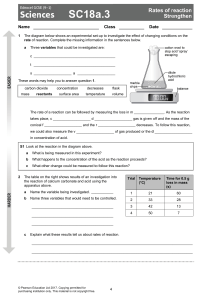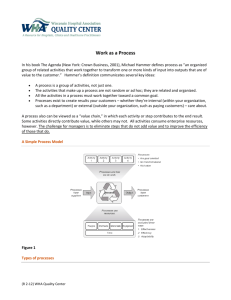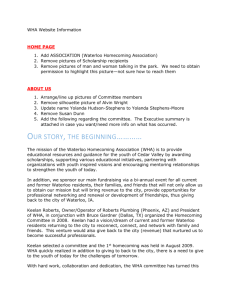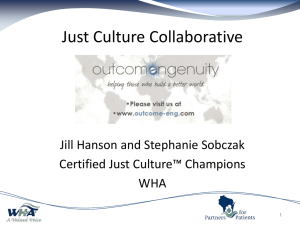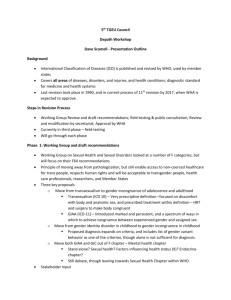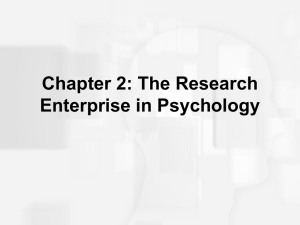WHA Partners for Patients Just Culture Implementation Guide
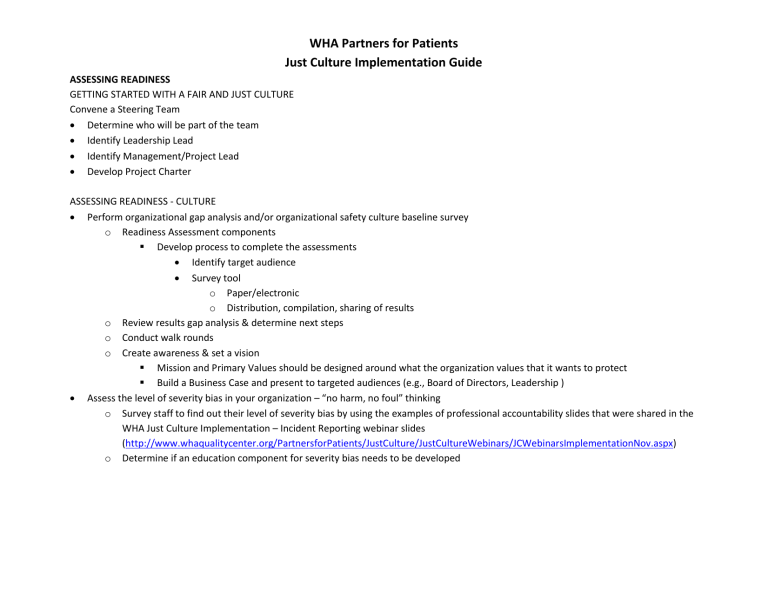
WHA Partners for Patients
Just Culture Implementation Guide
ASSESSING READINESS
GETTING STARTED WITH A FAIR AND JUST CULTURE
Convene a Steering Team
Determine who will be part of the team
Identify Leadership Lead
Identify Management/Project Lead
Develop Project Charter
ASSESSING READINESS - CULTURE
Perform organizational gap analysis and/or organizational safety culture baseline survey o Readiness Assessment components
Develop process to complete the assessments
Identify target audience
Survey tool o Paper/electronic o Distribution, compilation, sharing of results o Review results gap analysis & determine next steps o Conduct walk rounds o Create awareness & set a vision
Mission and Primary Values should be designed around what the organization values that it wants to protect
Build a Business Case and present to targeted audiences (e.g., Board of Directors, Leadership )
Assess the level of severity bias in your organization – “no harm, no foul” thinking o Survey staff to find out their level of severity bias by using the examples of professional accountability slides that were shared in the
WHA Just Culture Implementation – Incident Reporting webinar slides
( http://www.whaqualitycenter.org/PartnersforPatients/JustCulture/JustCultureWebinars/JCWebinarsImplementationNov.aspx
) o Determine if an education component for severity bias needs to be developed
WHA Partners for Patients
Just Culture Implementation Guide
ASSESSING READINESS - PROCESSES
Review existing HR policies, incident reporting practices, and disciplinary processes to determine how they align with a fair and just culture o Query staff, managers, and physicians regarding their current perceptions of the use of discipline in response to a person’s behavior
– depending on whether or not the behavior resulted in harm o Is there a process in place to routinely assess risk? o Does the incident reporting system allow for staff to report risk/events (e.g., a good catch/near miss reporting system)? o Is there a process in place to routinely assess risk? o Embed principles into system policies
Policies:
Corrective action
Performance appraisal
Problem resolution process
Management rights and responsibilities
Incident/occurrence reporting
Patient safety event/error reporting
Sentinel event investigation policy and process
Job descriptions
Discipline policies
Wording changes to incorporate “a fair and just culture” language
Categorize behavior – error, at-risk or reckless
Management response – console, coach or punish
Develop a timeline to revise policies and procedures to incorporate fair and just culture language and behaviors
Duties of managers are explicit (this is about seeing risk, designing safe systems and coaching/mentoring staff)
Duties of staff are explicit (the processes, but also looking for risk, reporting hazards and making safe behavioral choices
IMPLEMENTATION
IMPLEMENTATION – PHASE ONE
WHA Partners for Patients
Just Culture Implementation Guide
Engagement on all levels – Develop education materials and communication plan for a fair and just culture o All levels of management o All staff o Patients/families
Convene an implementation team o Determine who will be part of the team o Identify implementation lead o Develop Implementation Plan
Review current practices – determine if a “fair and just culture” are imbedded practices within the system o Incorporate into system wide initiatives
Hand washing
Medication reconciliation
Patient identification
Team training
Safe patient handling o Routinely use in root cause analysis process o Perform routine employee safety rounds o Ensure there is a process in place for staff to report risk/events, such as a good catch/near miss reporting system o Ensure there is a process in place to routinely assess risk
Designing an effective Just Culture system – How will you do the following in your organization: o Barriers - Prevent the error from occurring and/or prevents the hazard from touching target
Examples: Personal protective equipment; Covers/Shields; Interlocks; Control limits (preventing excess movement) o Redundancy – Allows the error to occur, but is caught by 2 nd or 3 rd strategy that is in place before the event occurs; Relies on parallel system elements to perform function of failed system component
Examples: Second person performing task, Backup supplies, Backup power, Parallel tests o Recovery – Allows the error to occur, but is captured before it becomes critical
Examples: Downstream checks; Downstream tests; Making the error visible thru feedback o Perception of High Risk – Acts to limit at-risk behaviors by fostering focus on specific tasks being worked
IMPLEMENTATION – PHASE TWO – THE JUST CULTURE ALGORITHM
WHA Partners for Patients
Just Culture Implementation Guide
The Just Culture Algorithm is designed to evaluate individual behaviors, regardless of the outcome and can be used both pre and post event o Managing behavioral choices in a way that allows the organization to achieve the outcomes they desire o Provides a mechanism to better understand “near misses” and degree of risk o Ability to clearly distinguish between Human Error, At-Risk Behavior, and Reckless Behavior o Utilize algorithm consistently to determine the actions taken as a result of an investigation
Understanding the algorithm o Request copies of the Just Culture algorithm from WHA o Review existing event investigation process to ensure it is addressing the following questions:
What happened?
What normally happens?
What does procedure require?
Why did it happen?
How were we managing it? o Revise existing event investigation processes to align with what was found during the review period
What training protocols will also need to be updated to accommodate this?
How will this change be shared with management and staff?
Who will be responsible for ensuring this will happen? o Practice using the Just Culture algorithm with actual event investigation cases
As you walk thru the cases using the algorithm be thinking about:
How easy is the algorithm to follow (i.e., level of severity bias)?
How will levels of severity bias be addressed for management? Staff?
How will managers be educated on how to use the algorithm?
How will staff be educated on using the algorithm?
Determine system-wide expectations of when and how to use the algorithm o Develop education component for the Just Culture Algorithm (see phase three – training) and revised event investigation practices
IMPLEMENTATION – PHASE THREE - TRAINING
Fair and Just Culture training incorporated into, accountability is established and communicated via: o Organizational-wide training for all employees as appropriate to their functions
WHA Partners for Patients
Just Culture Implementation Guide o Accountability is established and communicated (leader, staff, and management) o Revised policies and procedures are communicated to leaders, management and staff o New employee orientation
Educate on current reporting system
Demonstrate how staff are held accountable for behaviors versus outcomes o Management and new manager training
Hold organizational-wide training for all applicable management
Establish a process for managers to consistently work with human resources prior to any disciplinary action o Medical leadership training
Training on creating a safety-supportive culture, supporting an open reporting environment while holding employees accountable for their choices o Staff training
Hold organizational-wide introductory training for clinical staff
Educate staff on their role in a fair and just culture environment – looking for risk, reporting hazards and making safe behavioral choices o Patients/Families
Establish process to educate patients and families on patient safety and their ability/role with patient safety, including asking questions and speaking up with any safety questions or concerns
IMPLEMENTATION – PHASE FOUR – EMBEDDING FAIR AND JUST PRACTICES INTO THE ORGANIZATION
Fair and just culture concepts are infused and embedded in regular routines/practices throughout the organization o Concepts are routinely used in the root cause analysis process (e.g., drifting, coaching) o Becomes a regular management meeting agenda o Concepts are routinely used in the peer review process o Principles are incorporated into performance improvement o Principles match with employment/practice agreements (e.g., physician code of ethics/behaviors)
IMPLEMENTATION EVALUATION
Conduct periodic gap analysis and/or organizational safety culture tool review
Identify and review work done for safe systems design
WHA Partners for Patients
Just Culture Implementation Guide o What’s working? o How is patient care impacted?
o Future goals?
Analyze safe behavioral choices by reviewing HR discipline issues, good-catch reporting system, unsafe choices in RCAs
Utilize algorithm with event investigations on a routine basis
Establish and review error rate and other leading process improvement indicators (e.g., good-catch system)
Measure outcomes associated with improvement projects
